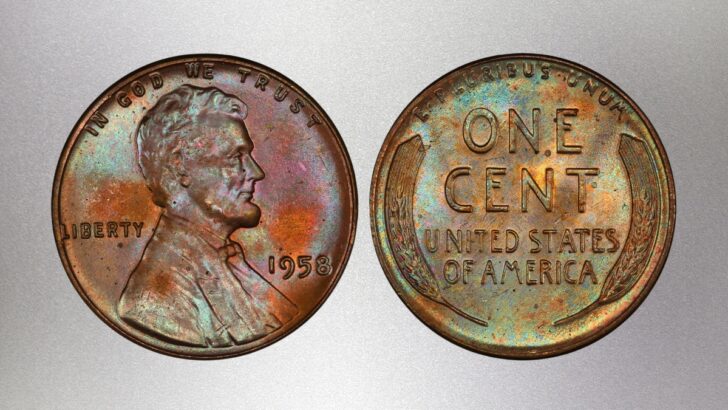The year 1958 would mark the end of an era in American coinage history. The Lincoln wheat penny, introduced in 1909, would see its last year of production. While the obverse, with a profile portrait of Abraham Lincoln, would remain the same, the reverse, showing the stylized stalks of wheat that gave the coin its name, would be supplanted in 1959 with a view of the Lincoln Memorial.
Because the 1958 wheat penny thus marks a “last-year-of-issue,” the coin attracts some attention from collectors. It otherwise is available in large numbers, at all grade levels, and is expensive only at the highest levels of value. Collectors of all skill levels and budgets can find examples that fit their needs, and the problem may be deciding upon which of several equally nice examples one wishes to purchase.
Production of the 1958 Wheat Penny
In 1958, the U.S. Mint’s production of Lincoln wheat pennies took place in two of the nation’s three mints. Denver produced far and away the most of the little bronze coins, a little over three-quarters of the total, while Philadelphia provided the rest. Philadelphia also produced the proof coins minted this year. Together, the two mints produced over a billion pennies.
| Date | Philadelphia | Denver | San Francisco |
| 1958 | 252,525,000 | 800,953,300 | 0 |
| 1958 Proof | 875,652 | 0 | 0 |
How Much Are 1958 Wheat Pennies Worth?
Given the huge mintage struck, 1958 wheat pennies aren’t especially valuable, except at the very highest, choicest uncirculated grades. The fact that the year marks the last of the wheat penny design adds a certain amount of value, as many collectors wish to add the coins for completeness, but there are still many to choose from at every grade level. The doubled die variety is scarce, almost unique, and unless one has an astronomical budget, outside the realm of possibility to obtain.
| 1958 Penny Value Chart | |||
| Business Strike | |||
| Date | Grade | ||
| Uncirculated MS63 | Uncirculated MS65 | Uncirculated MS67 | |
| 1958 1C BN | $0.40 | $2.15 | $47.25 |
| 1958 1C RB | $0.55 | $4.05 | $61.00 |
| 1958 1C RD | $0.80 | $10.80 | $436.00 |
| 1958-D 1C BN | $0.40 | $2.15 | $47.25 |
| 1958-D 1C RB | $0.55 | $4.05 | $61.00 |
| 1958-D 1C RD | $0.80 | $10.80 | $234.00 |
| Proof Strike | |||
| Date | Grade | ||
| PR65 | PR67 | PR69 | |
| 1958 1C RD | $3.71 | $27.00 | $260.00 |
| 1958 1C CAM | $20.25 | $88.00 | $845.00 |
| 1958 1C DCAM | $260.00 | $650.00 | $14,400.00 |
Values for 1958 Wheat Pennies
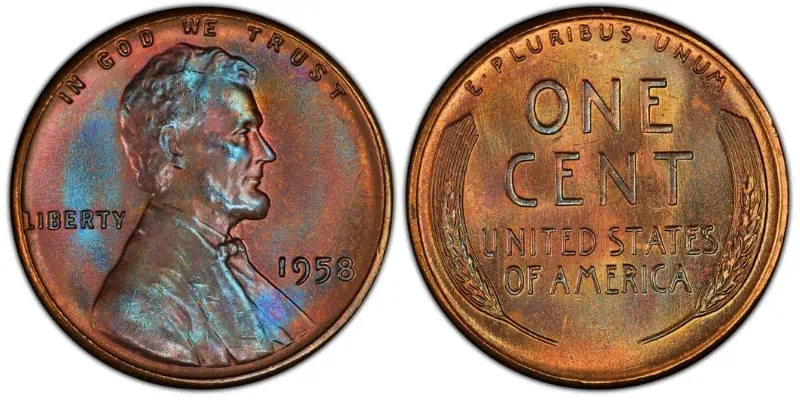
Wheat pennies struck in 1958 are common and readily available in all grades. In general, while the strike quality and sharpness of detail vary, many excellent coins, showing crisp, full detail, are easily found.
Circulated 1958 wheat pennies can be purchased quite inexpensively. Good and Fine specimens will cost $0.18 or $0.19 at coin shops or dealers, or at coin shows. Slightly better Extremely-Fine or About-Uncirculated varieties will cost only slightly more and can be found for less than $0.25. Such coins will look very nice in a penny folder, or in a display created by a beginning collector.
Uncirculated coins at the lower grades, and in brown or red-brown tones, are only slightly more expensive. A 1958 wheat penny, graded MS-63, should cost about $0.40 if brown, and about $0.55 if red-brown. Even a shiny red uncirculated penny graded MS-63 should cost less than $1.
Slightly better uncirculated coins are still affordable. A 1958 wheat penny, graded MS-65 should cost a little over $2 if brown, or a little over $4 if red-brown. A 1958 MS-65 RD wheat penny should cost around $10.80.
At the top uncirculated states, 1958 wheat pennies become more expensive and begin to have significant value. A 1958 penny graded MS-67 BN should cost under $50, while a red-brown specimen should cost just a bit over $60. A 1958 penny graded MS-67 RD can be found for somewhat over $150 or more. Coins with a somewhat better appearance may sell for more. In December 2023, a 1958 wheat penny, graded MS-67 RD, sold for $164 at Heritage Auctions.
Values for 1958-D Wheat Pennies
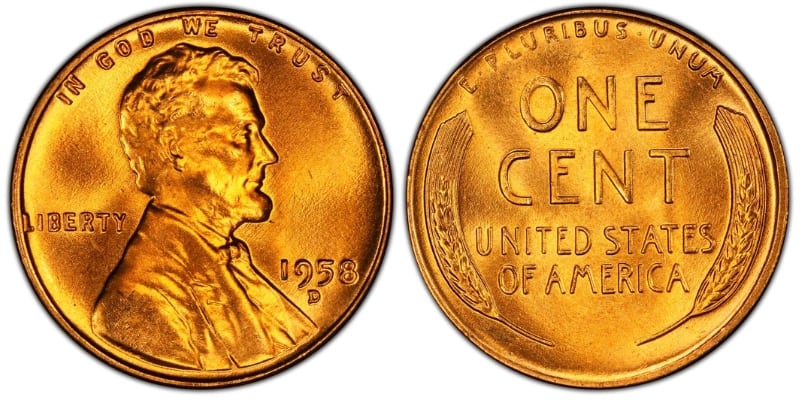
If 1958 wheat pennies minted in Philadelphia are common, then 1958-D wheat pennies from Denver are about three times more common, and the values are highly similar.
As before, Good and Fine 1958-D wheat pennies should cost $0.18 or $0.19, and Extremely-Fine or About-Uncirculated 1958-D specimens should cost around $0.20 or $0.21.
Uncirculated brown 1958-D pennies should cost between $0.40 and $0.80 in MS-63 grades, depending upon tone, whether brown, red-brown or red. In MS-65 grades, a 1958-D penny should cost between $2 and $11, once again depending upon tone.
At grades of MS-67, the price of 1958-D brown and red-brown pennies will be the same as those of 1958 wheat pennies for the same grade and tone, namely, between $45 and $60. Red 1958-D wheat pennies in this grade are slightly less valuable, and can be found for about $100. In December 2023, Heritage Auctions sold a 1958-D wheat penny graded MS-67 RD for $104. A month later, a similar coin sold for virtually the same price, at $105. A couple of 1958-D uncirculated wheat pennies fared a little better, and fetched better prices at Stack Bowers Auctions. In November 2023, a 1958-D wheat penny, graded MS-67 RD sold for $192 at Stack Bowers. In the same auction, a second, similar coin, sold for $144.
Were Any 1958-S Pennies Minted?
Despite the fact that the Treasury built a new facility for the San Francisco Mint in 1937, no effort was made to upgrade the production techniques or machinery. Instead, the obsolete processes used in San Francisco fell further and further behind, with increasingly smaller coin production runs.
In 1955, the Treasury halted production at the San Francisco Mint, and made no plans to reopen the facility. Production remained at a stand-still for 13 years, until 1968, when the Mint reopened to make proof coins. In some years between 1968 and 1974, the San Francisco Mint also struck ordinary circulating coins.
In 1958, the San Francisco Mint was closed, and so there are no genuine 1958-S wheat pennies.
Values for 1958 Proof Wheat Pennies
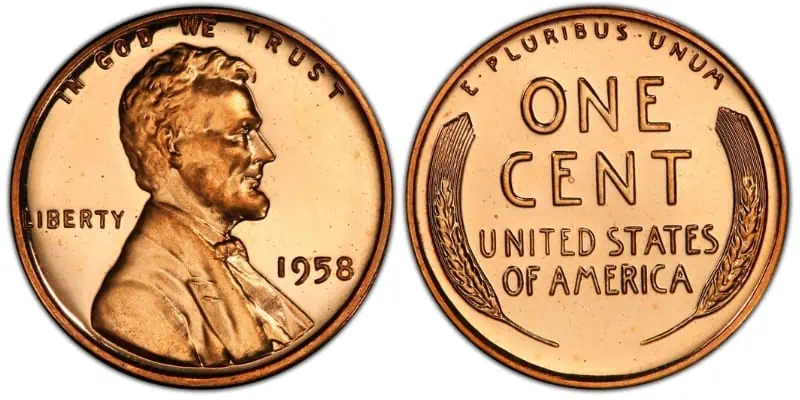
Proof wheat pennies for 1958 are readily available in the marketplace. In the 1950’s the Mint did not focus on cameo or deep cameo proof production. Instead, only the first handful of strikes out of any given proof die produced the unusual cameo or deep cameo appearance. As the die worked through use, it produced only proof strikes thereafter. Accordingly, finding a 1958 proof penny with a cameo finish is uncommon, while deep cameo proof pennies are hard to come by.
In evaluating proof coins, the point to bear in mind is that the term refers to a method of striking, not necessarily a condition or grade. Thus, the same measure of tone descriptors can be applied, and one can have proof wheat pennies that have oxidized to brown or red-brown. Such coins can be found, and can trade at prices similar to those of uncirculated coins of the same grade. At a grade of PR-63, 1958 pennies can be found at prices around $2, depending upon tone. Slightly better graded PR-65 pennies command slightly higher prices, but can still be found at prices under $4. Very nice PR-67 pennies can be found at prices beginning at $13, if brown, and ranging up to $27 for red proof coins with no cameo finish.
High grade proof pennies are somewhat more expensive. In October 2023, a 1958 proof wheat penny, graded PR-69 RD, sold for $129.
Because the Mint simply struck proof coins, without paying much attention to the nature of the finish, cameo and deep cameo pennies were a hit-or-miss proposition in the 1950s. Their existence was purely a matter of the state of the die used for striking at that moment. Prices reflect this scarcity.
In November 2018, a 1958 proof wheat penny, graded PR-68 CAM sold for $432 at auction. The auction note suggested that about 28 similar examples were known at that grade. In November 2023, a more modest 1958 proof penny, graded at PR-67, sold for $124.
In 2019, a deep cameo 1958 proof wheat penny, graded PR-68, sold for $4,080 at Heritage Auctions. In 2018, a similar coin sold for $6,600 at Heritage. The catalog for the second coin argued that there were no finer specimens known.
Another viable option is to acquire a complete proof set; one ends up with the penny, and, depending upon the focus of a collection, the other coins can be retained either for display or to store the value, or sold on to finance further penny purchases. A PR-68 proof set of 1958 coins, including a 1958 wheat penny, sold at Heritage Auctions for $186 in September 2022.
How Much Are 1958 Wheat Penny Varieties Worth?
Many collectors deliberately seek out “defective” coins, either in the form of coins struck on defectively manufactured dies, or coins which did not fall correctly into or out of the coin press. Other kinds of errors also exist. This segment of the coin collecting hobby has its own standards and terminology, and the market is big enough that one can speak of values. The demand is such that error coins of different sorts trade at a premium to ordinary coins of similar grade.
Sometimes, very rare examples of errors surface, which are unique, or nearly so. These coins quickly take on near-mythological status within the numismatic hobby. One of these arose in 1958 in wheat penny production.
What is the Value of the 1958 Wheat Penny Doubled Die Variety?
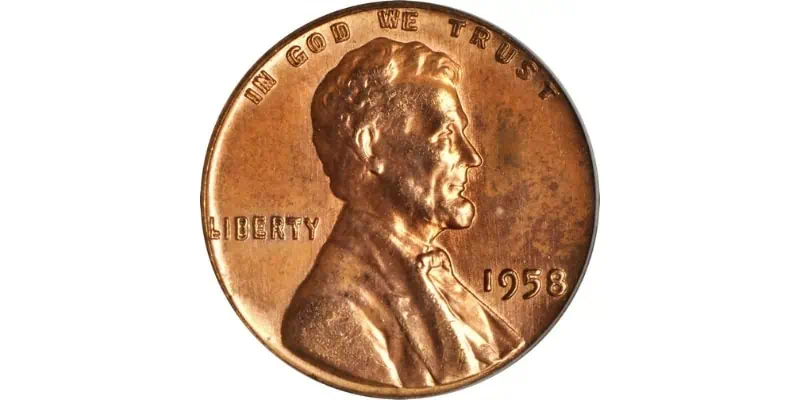
One of the legendary error coins unattainable to most ordinary collectors is the 1958 doubled die wheat penny. Although it is listed in coin catalogs, and has a Fivaz-Stanton number of FS-1-1958-101, there appear to be only two or three known examples. Numismatic historian David Bowers speculates that the problematic die used in production was found early on in its life cycle, and replaced rather than retained. He points out that, given ordinary wear, a wheat penny die of the era was used for between 800,000 and 1,000,000 strikes before being replaced. In a typical case, there would be many surviving examples, at all grade levels.
Instead, two examples of the 1958 DDO wheat penny were discovered, allegedly around 1960, by a collector, who claimed he found them searching a $50 sack of 1958 wheat pennies. They remained generally unkown until the 1980s when they were debuted at a New Jersey coin show specializing in error collections. Despite further, and undoubtedly enthusiastic, picking efforts, only one other specimen has ever come to light since. Bill Fivaz and J.D. Stanton argue that the existing coins all came, “directly or indirectly,” from a Philadelphia Mint worker. Given the lack of other examples, they go on to argue that this is not a true mistake, though they stop just short of saying it is a deliberate imposition created by Mint employees for personal gain.
Bowers relates that in 2005, one specimen of the 1958 DDO wheat penny set a record sale price for any doubled die penny variety, when it sold for $100,000. The coin graded at MS-65 RD. The other coin graded at MS-64 RD. It sold for $25,025 in 1996.
More recently, the 1958 DDO wheat penny graded at MS-64 RD returned to the market, at Stack Bowers. At auction in 2018, it realized a price of $336,000.
Fivaz and Stanton suggest that buyers be exceedingly cautious in evaluating any claimed 1958 DDO wheat penny offered for sale. Despite all this, if collectors wish to try their luck, the coin has doubling more easily observed in the lettering than in the date, but all the lettering is pretty clearly affected.
Technical Specifications of the 1958 Wheat Penny
As with all previous wheat pennies, the 1958 wheat penny, the last of the series, is a bronze coin, with a weight of 3.11 grams and 19 millimeters. It is not pure copper, but an alloy of 95% copper and 5% zinc and tin.
The design of the Lincoln wheat penny was initiated in 1909, as part of a general redesign of American coinage instigated by Theodore Roosevelt. The particular motif, of Abraham Lincoln, was selected to commemorate the centennial of the birth of America’s sixteenth President. The reverse, a stylized wreath of wheat, was in keeping with similar designs on low-denominations of European coins at the time. The designer, engraver and medallion sculptor, Victor D. Brenner, was selected in part because he had prepared a bust of President Roosevelt.
The design was immediately and immensely popular with the American public. As a measure of that popularity, the design carried on unchanged from 1909 to 1958, even though Treasury officials could have substituted a new design without Congressional approval after twenty-five years had passed.
The onset of 1959 would mark some changes, however, as some action seemed necessary to commemorate the 150th anniversary of Lincoln’s birth. The result would be a change on the reverse of the coin, from the wheat penny wreath to the Lincoln Memorial. Even so, the wheat penny series became one of the longest running coin designs in American history, and the Lincoln penny series ran, and runs, even longer, continuing to this day.
Summary
Leaving aside the 1958 DDO, which is a unique case, the 1958 wheat penny is important for historical reasons as the last of a series. As such, it has a place in every Lincoln penny collection. Fortunately, there are 1958 wheat pennies available at quite modest prices fit for every collecting purpose and every budget.
